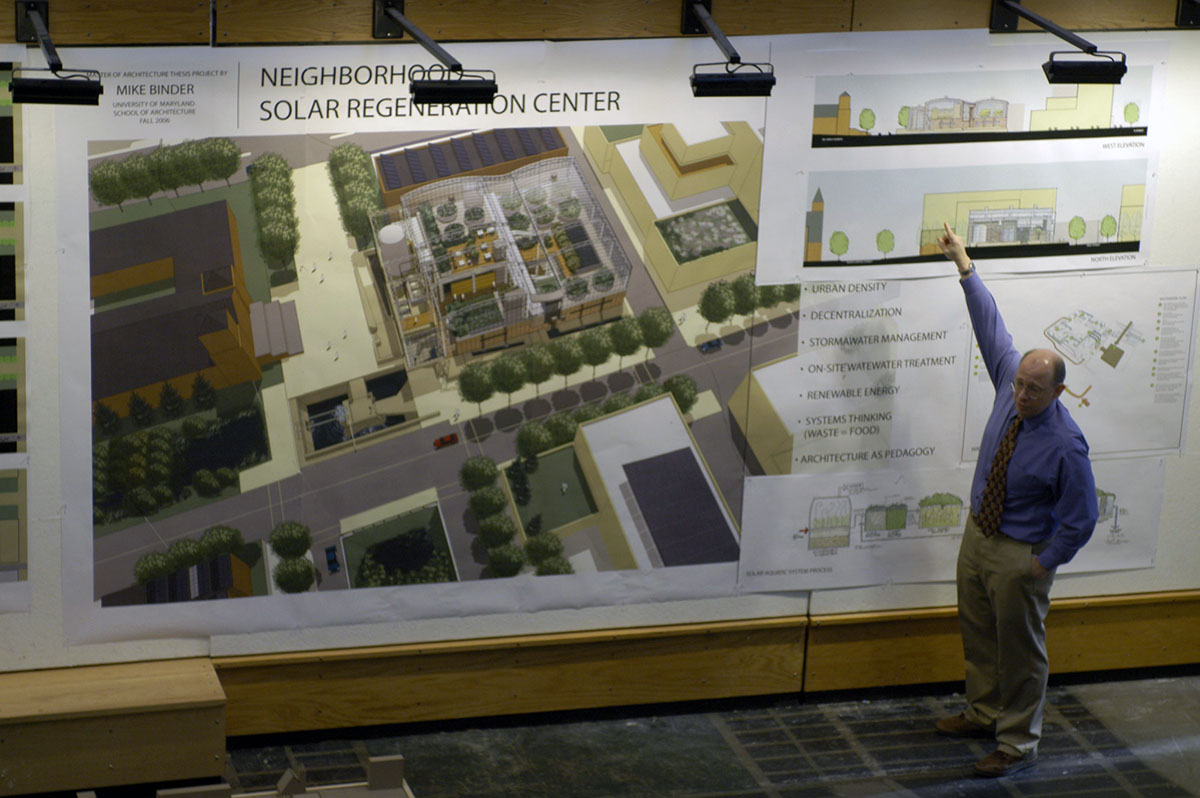For Associate Clinical Professor Mike Binder (M.Arch ‘06), teaching architecture wasn’t rocket science. He knows, because he did that—in a former life at NASA before scratching an itch to leverage his science mind to propel sustainable, regenerative design.
Teaching architecture for UMD’s School of Architecture, Planning and Preservation was a literal labor of love for Binder: in studio, on the competition stage, as a mentor and advisor.
Binder, who retires this month, has taught the intricacies of structural technology, a complex and often intimidating requirement for students, through cardboard bridges and solar houses, capitalizing on his passion for bettering the built environment as well as his natural creativity.
“Mike is a dedicated and passionate educator who has been a cornerstone of our faculty for technology courses at MAPP,” said Notre Dame Associate Professor Ming Hu, who co-taught an advanced technology course with Binder. ”Mike's commitment to imparting practical and insightful knowledge to his students has left an indelible mark on countless young minds, preparing them for successful careers in the field.”
Binder began his 38-year career working on particle physics and completing graduate work at CERN, the Accelerator Laboratory in Geneva, Switzerland. He transitioned into engineering, where he specialized in system simulation of rockets and jet engines as a contractor for IBM and NASA before switching to architecture.
“I'd always been interested in sustainability partly because I'm a systems guy and sustainability is like the ultimate in systems disciplines,” said Binder. “It's combining not only engineering and physics, but also design. So, I made the change to architecture to do something I'd always wanted to do.”
Binder returned to school to obtain his master’s in architecture at UMD in 2003—and stayed. During his tenure with MAPP, he guided students through the complex yet necessary concepts of sustainable systems, structural principles, energy modeling, lighting and HVAC.

In addition to teaching, he served as an executive committee member of reACT ThinkTank and participated in four Solar Decathlons: as a student in 2005, as a mentor with LEAFHouse in 2007, and as a faculty advisor for WaterShed in 2011 and reACT in 2017. LEAFHouse and reACT placed second, while WaterShed took first place internationally.
Outside of teaching, Binder worked as a registered architect and LEED AP BD+C on high-performance, single-family residential projects through his business, Binder Regenerative Design Studio, at Meditch-Murphey Architects and with Clinical Professor Amy Gardner through Gardner Architects (then Gardner Mohr Architects) from 2006 to 2008. At Gardner Mohr, Binder was central to the design and completion of an award-winning LEED-Gold certified home along the South River in Annapolis, Md.
“Mike is an extraordinary person,” said Gardner. “He is able to think in conceptual and technical terms in a synthetic way and explore and represent his ideas through a vast spectrum of techniques, from his beautiful sketches to finely crafted and constructed technical drawings and models.”
Binder’s academic and professional career opened doors to designing his own home and his neighbors' too, as architect of record for the senior co-housing community where he lives in Shepherdstown, West Virginia. Leveraging his expertise in sustainable technologies, each home is equipped with solar panels. An organic community garden is named for his late wife Martha, who played a major role in its creation.
Retirement will put the structural work of houses and buildings behind him, leaving Binder time to concentrate on other towering marvels: decorative cakes, a hobby he loved as a kid, along with cartooning. But unlike the models created in studio, these tasty treats have a destination other than the dumpster outside the fabrication lab.
“I’ll be able to make something creative, but at the end of the day, you get to eat it,” he said.

